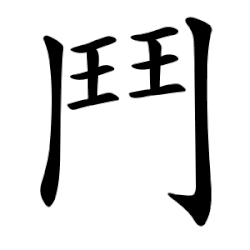Radical 191
| 鬥 | ||
|---|---|---|
| ||
| 鬥 (U+9B25) "fight" | ||
| Pronunciations | ||
| Pinyin: | dòu | |
| Bopomofo: | ㄉㄡˋ | |
| Wade–Giles: | tou4 | |
| Cantonese Yale: | dau3 | |
| Jyutping: | dau3 | |
| Japanese Kana: | トウ tō (on'yomi) たたか-う tataka-u (kun'yomi) | |
| Sino-Korean: | 투 tu | |
| Hán-Việt: | đấu, dấu | |
| Names | ||
| Japanese name(s): | 闘構/たたかいがまえ/とうがまえ tatakaigamae / tōgamae | |
| Hangul: | 싸울 ssaul | |
| Stroke order animation | ||
 | ||
Radical 191 or radical fight (鬥部) meaning "fight" is one of the 8 Kangxi radicals (214 radicals in total) composed of 10 strokes.
In the Kangxi Dictionary, there are 23 characters (out of 49,030) to be found under this radical.[1]
鬥 is also the 190th indexing component in the Table of Indexing Chinese Character Components predominantly adopted by Simplified Chinese dictionaries published in mainland China. However, this radical character 鬥 and former radical 169 門 "door" were merged to 门 during the simplification. 鬥 is therefore no longer in use in Simplified Chinese and is retained as an indexing component only for historical reasons.
Evolution
-
 Oracle bone script character
Oracle bone script character -
 Large seal script character
Large seal script character -
 Small seal script character
Small seal script character
Derived characters
| Strokes | Characters |
|---|---|
| +0 | 鬥 |
| +4 | 鬦 (=鬥) |
| +5 | 鬧 |
| +6 | 鬨 |
| +8 | 鬩 |
| +10 | 鬪 (=鬥) |
| +12 | 鬫 |
| +14 | (=鬭) 鬭 (=鬥) |
| +17 | 鬮 |
References
- ^ "Unihan data for U+9B25". Unicode Consortium. Retrieved 26 March 2011.
Literature
Wikimedia Commons has media related to Radical 191.
- Fazzioli, Edoardo (1987). Chinese calligraphy : from pictograph to ideogram : the history of 214 essential Chinese/Japanese characters. calligraphy by Rebecca Hon Ko. New York: Abbeville Press. ISBN 0-89659-774-1.
- Lunde, Ken (Jan 5, 2009). "Appendix J: Japanese Character Sets" (PDF). CJKV Information Processing: Chinese, Japanese, Korean & Vietnamese Computing (Second ed.). Sebastopol, Calif.: O'Reilly Media. ISBN 978-0-596-51447-1.